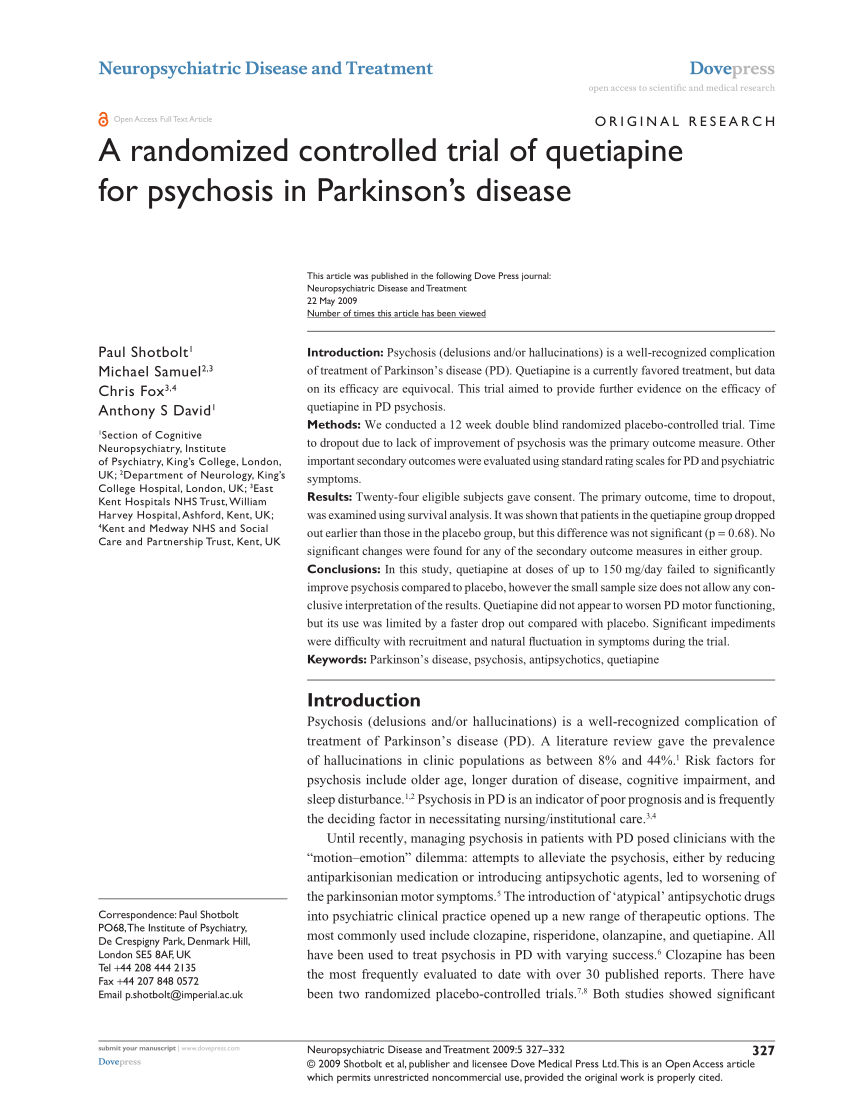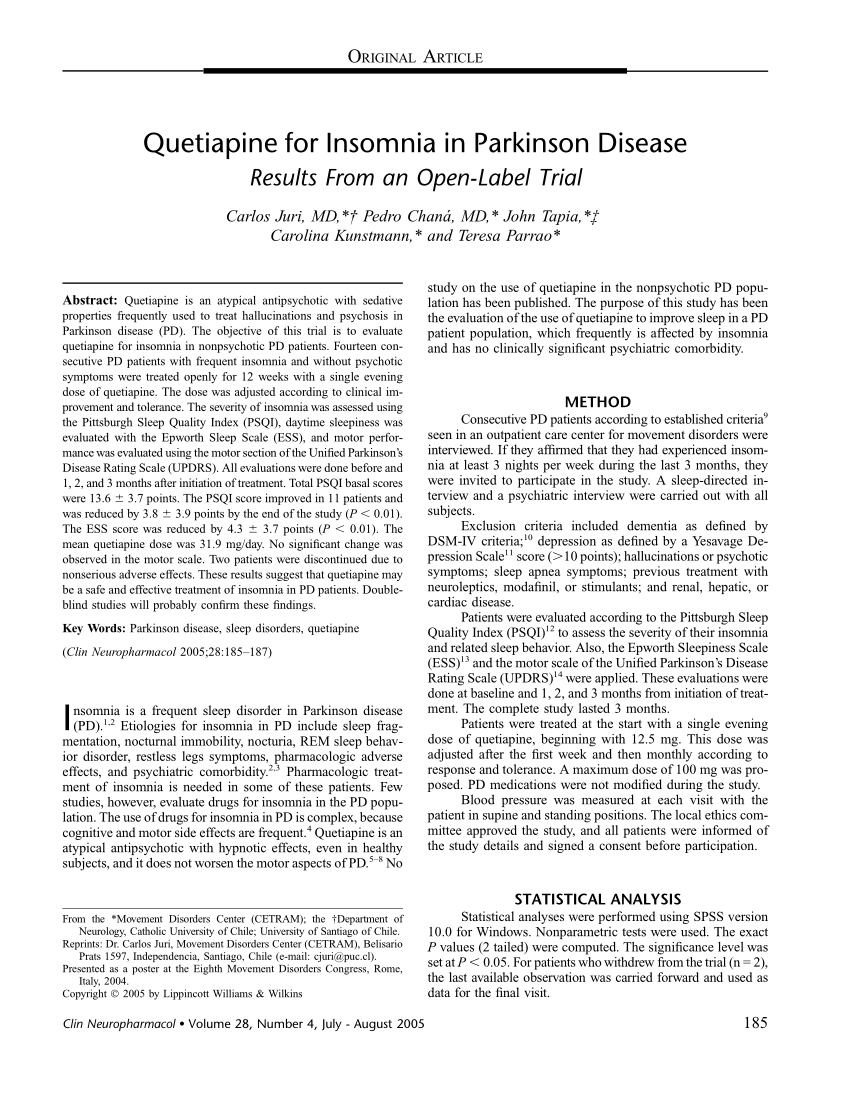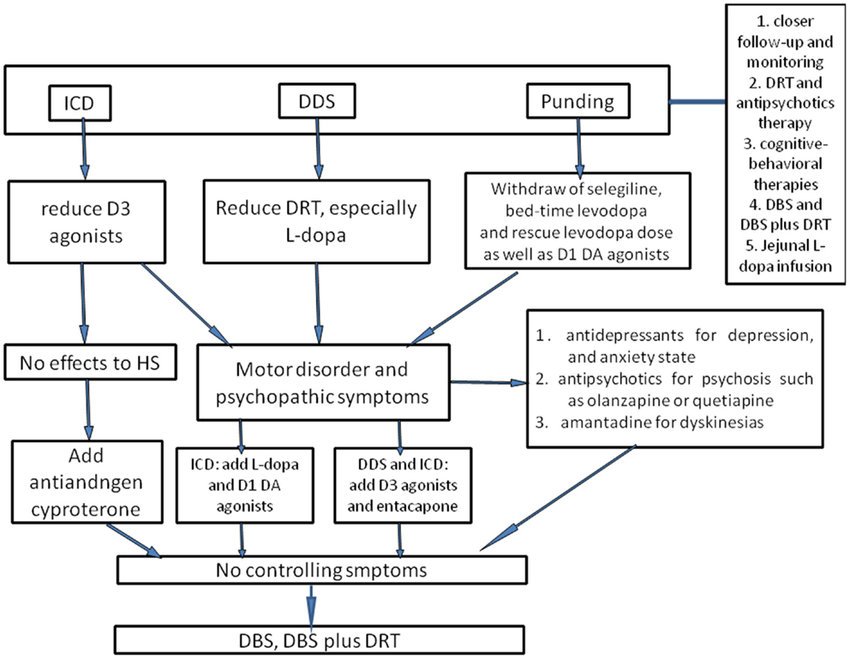Overview Of Pdp Management
Physical Versus Emotional Control:The intertwining pathophysiology of psychosis and PD through dopaminergic pathways presents healthcare professionals and patients with the unfortunate choice between physical and emotional stability. Dopaminergic agents that treat the symptoms of PD and maintain physical control are predominately associated with the triggering of psychosis symptoms through D2-receptor activation.9,11 This swing to emotional instability could be broadly treated in one of two ways. One option is to stop the anti-PD agent however, this is not feasible for most patients because physical instability and motor symptoms would return. Alternatively, an antipsychotic could be added, but nearly all typical and atypical antipsychotics work via D2-receptor antagonism, potentially tipping the scale toward physical instability. Accordingly, methods used in practice involve dose reduction of offending agents, as tolerated, or the use of an atypical antipsychotic with low D2-receptor affinity.9,11
This Antidepressant May Be No Better Than Cheaper Alternatives But Demand Could Soon Soar
Nuplazid, if given the FDA go-ahead, would undoubtedly cost far more than existing antipsychotics, which are mostly used to treat schizophrenia and are available as generics. In the pivotal trial behind Acadias marketing application, Nuplazid showed only modest improvements over placebo, and was tested in a way that makes it difficult to compare against other treatments.
Physicians involved in the trial stand by the drug, nonetheless.
Dr. Jeffrey Cummings, a neurologist at the Cleveland Clinic Lou Ruvo Center for Brain Health in Las Vegas, said he was struck by some of the patients dramatic responses.
Of course, families will also respond to placebos, and thats why we dont approve drugs based on anecdotal reports, said Cummings, who has taken consulting fees from Acadia. But when families are saying this really made a difference for his life and our lives together, for me it was a pretty impressive study.
Parkinsons psychosis usually occurs in the latter stages of the disease, and generally involves nonthreatening visual hallucinations. Cynthia Hatfield, a 72-year-old former banker living in Westerly, R.I., several times a week sees a calico cat resembling one shed actually owned many years ago, and which her children named Mushroom. For years, her hallucinations included a menagerie of small animals.
Chipmunks and little squirrels and cats, and a little mouse would come out every once in a while, she said. I actually enjoy seeing them.
Identifying Psychosis Diagnosis And Antipsychotics
The purpose of this study was to identify the incidence of new cases of antipsychotic use to treat psychosis in the first year after PD diagnosis. To be considered an antipsychotic user, first, a patient was required to have a new Read Code of psychosis diagnosis that appeared in the data after the diagnosis of PD diagnosis. Additionally, the Read Code for antipsychotics must have appeared after the diagnosis of psychosis and within the first year after PD diagnosis. Appendix 2 lists drugs considered antipsychotics and their drug classes .
Recommended Reading: Social Security Blue Book Parkinson’s
Pimavanserin Is Associated With Better Physician
Neurology Reviews
MIAMIAs a treatment for Parkinsons disease psychosis, pimavanserin is associated with significantly improved outcomes, compared with quetiapine and other therapies, according to research presented at the Second Pan American Parkinsons Disease and Movement Disorders Congress. The data suggest that use of pimavanserin is associated with significantly improved treatment outcomes, both within and beyond six months of treatment, said Conrad Tenenbaum, PhD, Senior Associate at BluePrint Research Group in Princeton, New Jersey, and colleagues.
Conrad Tenenbaum, PhD
More than half of patients with Parkinsons disease develop related psychosis. According to Dr. Tenenbaum and colleagues, most clinicians prescribe quetiapine for Parkinsons disease psychosis, but clinicians report that pimavanserin is more likely to provide adequate control of symptoms. To probe this discrepancy, Dr. Tenenbaum and colleagues investigated current treatments and outcomes for patients with Parkinsons disease psychosis to improve disease management.
Quetiapine Improves Symptoms Of Parkinson’s Disease

New York Mar 2 In patients with Parkinson’s disease and psychosis who failed treatment with other atypical antipsychotic agents, quetiapine improved both cognitive and psychotic symptoms. These results from a 6-month, open-label study were presented this week at the American Association for Geriatric Psychiatry meeting in San Francisco, California. Seroquel is indicated for the treatment of schizophrenia.
The single-center study examined the safety, tolerability, efficacy, and cognitive effects of quetiapine in 29 patients with psychosis associated with Parkinson’s disease who had failed treatment with clozapine, risperidone, or olanzapine due to lack of efficacy, intolerable adverse effects, or noncompliance with blood monitoring. Patients received up to 400 mg/day of quetiapine, which was dosed according to clinical response and tolerability for up to 6 months.
Psychiatric assessments included the Brief Psychiatric Rating Scale , the Clinical Global Impressions Severity of Illness item, the Neuropsychiatric Inventory sum of delusions and hallucinations , and the Unified Parkinson’s Disease Rating Scale mental subscale and a modified Hoehn and Yahr assessment. Assessments for Parkinson’s disease symptoms included the remaining UPDRS subscales.
Three patients withdrew from the study due to adverse events.
Also Check: Non Shaking Parkinson’s Disease
Top Other Side Effects For These People *:
Interested In Parkinsons Disease Research Register For Our Forums And Join The Conversation
Besides Nuplazid, the team focused on Seroquel, a second-generation antipsychotic , which is often used to treat Parkinsons psychosis. Results were mixed. Use of Seroquel and other SGAs led to concerns about increased morbidity and mortality in patients with dementia or those with Parkinsons, prompting an FDA black box warning.
Unlike Seroquel, Nuplazid does not affect dopamine receptors, so it does not interfere with the effectiveness of Parkinsons treatments for motor symptoms.
The team conducted a retrospective analysis of 4,478 UC San Diego Health patients with Parkinsons, of whom 676 were being prescribed Nuplazid, Seroquel, or both, between April 29, 2016 and April 29, 2018.
Results showed that patients treated with Nuplazid alone had a lower mortality percentage when compared to those treated with quetiapine only , or with both compounds . However, the differences were not statistically significant.
When compared to 784 Parkinsons patients not on these medications , the results revealed a significantly greater risk of mortality in the Seroquel-only group and a trend toward increased risk in the combination treatment group.
Its reasonable to assume, however, that individuals requiring these medications have greater disease severity and are at a higher risk of complications and death, Nahab noted.
Our findings provide the largest comparative report of mortality risk in , researchers wrote.
Also Check: Acupressure Points For Parkinson’s Tremors
Thanks For Signing Up
We are proud to have you as a part of our community. To ensure you receive the latest Parkinsons news, research updates and more, please check your email for a message from us. If you do not see our email, it may be in your spam folder. Just mark as not spam and you should receive our emails as expected.
Lack Of Treatment Alternatives
The researchers examined Department of Veterans Affairs patient records from fiscal year 2008, comparing the rates of antipsychotic drug prescriptions among two groups: 2,597 patients with Parkinson’s disease and psychosis with and without dementia and 6,907 patients with dementia and psychosis but without Parkinson’s disease 97.3% of the patients studied were men.
“More men are diagnosed with Parkinson’s, and men are more likely to develop dementia,” says Weintraub.
An estimated 60% of Parkinson’s patients will experience some form of psychosis during their illness, according to the study. Weintraub and colleagues found that half of all patients with Parkinson’s and psychosis were treated with antipsychotic medications.
Perhaps their most striking finding was that overall prescription rates had not decreased compared to 2002, despite the black box warning that was issued in 2005. To Fernandez, the reason is simple: doctors have few options to offer.
“This study is very important because it highlights the problem that clinicians face,” says Fernandez. “The problem is it’s not very easy to treat, and few patients will be completely treated.”
Weintraub agrees that treatment choices are quite limited, but he hopes that his study will encourage doctors to make greater use of clozapine and to be more conservative in prescribing other antipsychotics.
Don’t Miss: Prostate Cancer And Parkinson’s Disease
Top Conditions Involved For These People *:
How Common Is Parkinson’s Disease Psychosis
Between 20-40% of people with Parkinsons report the experience of hallucinations or delusions. When followed as the disease progresses over the years, this number increases. The increase does not mean that the hallucinations are persistent across the majority of patients. However, it is important to note that these statistics sometimes include delirium, in which the symptoms are temporary due to medication that needs to be adjusted or infection that needs to be treated, and isolated minor symptoms or minor hallucinations, including illusions, where instead of seeing things that are not there , people misinterpret things that are really there. These are the most common types of psychosis in people with PD, with different studies placing the occurrence between 25-70% of people with Parkinsons. Typically, if the person with PD only has these minor hallucinations, their doctor will not prescribe an antipsychotic medication, though more significant psychosis that requires medication may develop over time. In one study, 10% of those with minor hallucinations had their symptoms resolved within a few years, while 52% saw their symptoms remain the same and 38% saw their psychosis symptoms get worse.
We recommend that people with Parkinsons not use a single percentage to represent the prevalence of hallucinations and PDP. Parkinsons is a complex disease and as it progresses the percentages and risk of symptoms will change.
Don’t Miss: Who Discovered Parkinson’s Disease
What Treatments Are Available For Parkinsons Psychosis
Your doctor may first reduce or change the PD medication youre taking to see whether that reduces psychosis symptoms. This is about finding a balance.
People with PD may need higher doses of dopamine medication to help manage motor symptoms. But dopamine activity shouldnt be increased so much that it results in hallucinations and delusions. Your doctor will work with you to find that balance.
Pimavanserin Versus Quetiapine For The Treatment Of Psychosis In Parkinson’s Disease And Dementia With Lewy Bodies

Compared pimavanserin to quetiapine in the treatment of Lewy body-related psychosis.
-
Used time to discontinuation analysis as a real-world, pragmatic, primary outcome.
-
Found lower early and higher late discontinuation of pimavanserin compared to quetiapine.
-
Pimavanserin may be more clinically useful at promptly managing psychosis.
-
Patients may continue quetiapine long-term for secondary, delayed benefits.
You May Like: What Are The Complications Of Parkinson’s Disease
Motor And Nonmotor Symptoms Of Pd
At its core, PD is characterized by four cardinal symptoms: bradykinesia, rigidity, resting tremor, and postural instability.4 Along with these typical motor symptoms come many nonmotor symptoms with significant associated morbidity and mortality. These include autonomic dysfunction, disorders of sleep and wakefulness, cognitive dysfunction and dementia, mood disorders, and psychosis.5 These nonmotor symptoms of PD are responsible for a significant proportion of hospitalizations, with psychosis reportedly accounting for 24% of hospital admissions in patients with PD.6 This fact signifies the importance of properly managing patients with PD psychosis on both an inpatient and an outpatient basis.6
Diagnosis Of Dip And The Role Of Dat Imaging
The clinical diagnostic criteria for DIP are defined as 1) the presence of parkinsonism, 2) no history of parkinsonism before the use of the offending drug, and 3) onset of parkinsonian symptoms during use of the offending drug. Since asymmetrical rest tremors are common in many DIP patients and symptoms persist or progress after cessation of the offending drug, patients clinically diagnosed with DIP may include individuals in the preclinical stage of PD whose symptoms were unmasked by the drug.,,,
DATs are presynaptic proteins in the membrane on terminals of dopaminergic neurons. They take up dopamine from the synaptic cleft projections that extend from the substantia nigra to the striatum. These transporters control dopaminergic transmission by spatial and temporal buffering, rendering the molecule an imaging target in diseases affecting the dopaminergic nigrostriatal pathway. Single-photon-emission computed tomography and positron-emission tomography scans are available using several DAT ligands., SPECT radioligands include 123I-N-3-fluoropropyl-2-carbomethoxy-3-nortropane , 123I-ioflupane, DaTSCAN, and 123I-2-carbomethoxy-3-tropane . PET scans may be superior to SPECT for imaging DATs, in that the lower energy of positrons provides higher resolution, resulting in better image quality with widespread clinical applications. However, most DAT imaging studies, including those in patients with DIP, have utilized SPECT.,-
You May Like: Pesticides And Parkinson Disease A Critical Review
How Can Caregivers Support Their Loved Ones
Caring for someone who sees, hears, or believes things that arent real can be very difficult. Try to be as patient and calm as you can.
Avoid arguing with the person. If they still have insight, gently explain that what theyre seeing isnt real. Tell anyone who cares for or visits your loved one what to expect, and how to respond.
Stay in close contact with the persons doctor. If their symptoms dont improve, ask whether they need a medication adjustment.
Check whether the person needs hearing aids or glasses. Poor hearing or vision can sometimes lead to hallucinations. It can also help to turn on bright lights at night, to prevent the shadows that may trigger visual illusions.
Secure any dangerous objects, and keep pathways in the home clear to prevent falls and injuries. If you ever feel like the person is a risk to themselves or others, call their doctor.
Medications Used For Treating Psychosis
Antipsychotic agents are designed to balance abnormal chemical levels in the brain. Up until the 1990s, the use of antipsychotics in PD was controversial because the drugs used until that time work by reducing excess dopamine. This alleviated psychosis but caused dramatic worsening of PD motor symptoms.
Fortunately, medications that are better tolerated by people with PD are now available. Today, there are three antipsychotic medications considered relatively safe for people with PD: quetiapine , clozapine and the newest agent, pimavanserin . They cause limited worsening of PD while treating hallucinations and delusions.
You May Like: 5 Signs You Ll Get Parkinson’s
Identifying Early Pd Patients
Eligibility criteria included individuals with a first Read Code of a definitive PD diagnosis in GP data . The Read Code system is a hierarchical system that covers most clinical terms, including diagnoses and drugs.24 The Read Codes indicating a definitive PD diagnosis were used and validated in a previous study.25 Patients were excluded for the following reasons: less than 40 years of age, taking any antiparkinsonian drug before PD diagnosis, no prescription of any antiparkinsonian drug within one year after PD diagnosis, a first code of PD within 6 months from SAIL registration date, death within a year of PD diagnosis, and previous antipsychotic use within the year prior to PD diagnosis, as antipsychotics can cause Parkinson-like symptoms which could be mistakenly diagnosed as PD.26
Risk Factors For Psychosis
Not everyone with Parkinsons will develop hallucinations or delusions, but there are several things can increase your risk:
- Dementia or impaired memory
- Depression: Individuals suffering from depression and PD are at a greater risk. In addition, severe depression alone can cause psychosis.
- Sleep disorders, such as vivid dreaming. Individuals commonly report vivid dreaming prior to the onset of psychosis. Other associated sleep disturbances include REM sleep disorder and general insomnia.
- Impaired vision
- Use of PD medications
Also Check: Possible Causes Of Parkinson’s Disease
Direct Targeting Of Wild
1Department of Neurology, Northwestern University Feinberg School of Medicine, Chicago, Illinois, USA.
2German Center for Neurodegenerative Diseases , Munich, Germany.
3Metabolic Biochemistry, Biomedical Center , Faculty of Medicine, Ludwig Maximilians University, Munich, Germany.
4Munich Cluster for Systems Neurology , Munich, Germany.
5Department of Chemistry, Chemistry of Life Processes Institute, Center for Molecular Innovation and Drug Discovery, and Center for Developmental Therapeutics, Northwestern University, Evanston, Illinois, USA.
6Parkinsons Disease Center, Department of Neurodegenerative Science, Van Andel Institute, Grand Rapids, Michigan, USA.
Address correspondence to: Dimitri Krainc, Northwestern University Feinberg School of Medicine, 303 East Chicago Avenue, Ward 12-140, Chicago, Illinois 60611, USA. Phone: 312.503.3936 Email: .
LFB and JZ contributed equally to this work.
Find articles byBurbulla, L.in: |PubMed |
1Department of Neurology, Northwestern University Feinberg School of Medicine, Chicago, Illinois, USA.
2German Center for Neurodegenerative Diseases , Munich, Germany.
3Metabolic Biochemistry, Biomedical Center , Faculty of Medicine, Ludwig Maximilians University, Munich, Germany.
4Munich Cluster for Systems Neurology , Munich, Germany.
5Department of Chemistry, Chemistry of Life Processes Institute, Center for Molecular Innovation and Drug Discovery, and Center for Developmental Therapeutics, Northwestern University, Evanston, Illinois, USA.
What’s Hot In Pd: As A New Drug Gains Fda Approval For Parkinsons Disease Psychosis Should We Fear Using It

This week the FDA approved the drug Pimavanserin for the treatment of Parkinsons disease psychosis. There has been a critical, unmet need for development of better drugs to address hallucinations and psychosis in the setting of Parkinson’s disease. We have learned over many years that typical high potency neuroleptic antipsychotic drugs may improve hallucinations but do so at the cost of worsening Parkinsons disease motor symptoms and are associated with an increased mortality. We have changed our treatment strategy to address hallucinations in Parkinsons disease by using agents that will not worsen the common motor symptoms . We routinely choose quetiapine or clozapine instead of the classical dopamine blocking drugs. There are, however, shortcomings with these two drugs. Quetiapine has not been shown effective across several randomized Parkinsons disease clinical trials, but many Parkinson experts believe it is moderately helpful, particularly in the setting of mild hallucinations. Clozapine has been shown to be highly efficacious, but it requires weekly blood monitoring to check for a potentially life-threatening side effect called agranulocytosis where the drug attacks the bone marrow. The inconvenience and discomfort of blood draws have limited the penetration of this therapy.
Selected References:
Okun, MS. 10 Breakthrough Therapies in Parkinsons Disease. Books4Patients. 2015 .
Okun, MS. Should We Fear Antipsychotics in Parkinsons Disease Patients? 2015.
Also Check: What Is Bradykinesia In Parkinson’s